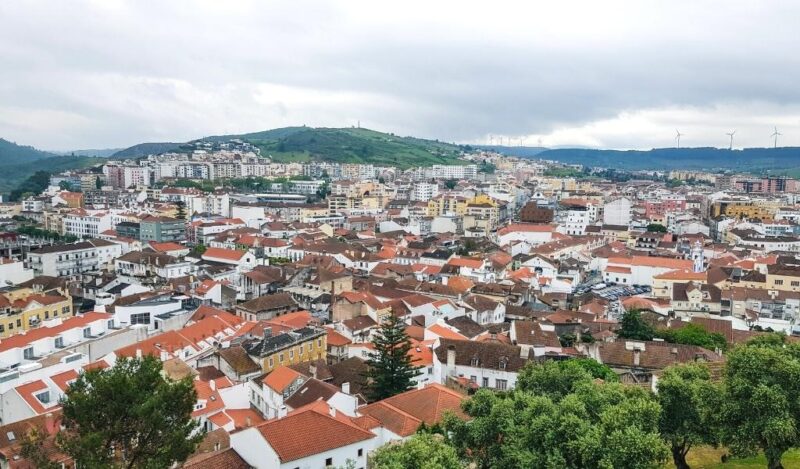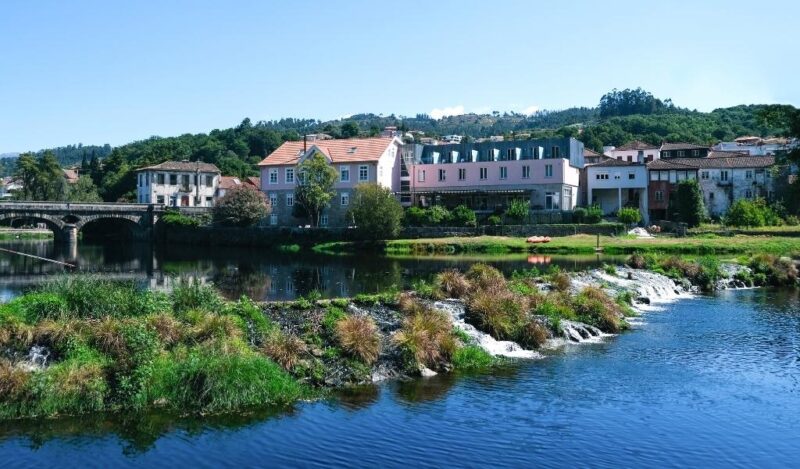Located in Mêda in the Guarda district, the small mountain village of Marialva is one of the “12 Historical Villages of Portugal” (a program created by the Portuguese government in 1991, to restore and enhance a series of villages in the Beira Interior region, older than the country itself). And Marialva might be just a small mountain village, but it hides one of the most beautiful medieval castles in the country!
The history of Marialva dates back to the 6th century BC and is marked by the successive presence of peoples, who changed its name: first, it was called City of Aravor (in the time of the Turduli) and then Civitas Aravorum (under the Roman Empire). St. Justus followed (with the arrival of the Visigoths) and Malva (with the Arab invasion)! In fact, the name Marialva only appeared in 1063, when it was conquered by Ferdinand I of León!
So, do you want to know more about 1 Day In Marialva: The Perfect Marialva Itinerary? Keep reading!
No time to read now? Pin it for later!


Brief History of Marialva
As I mentioned in the introduction, Marialva has a history prior to the foundation of Portugal as a country, as it dates back to the time of the pre-Roman peoples and tribes that inhabited the Iberian Peninsula. And curiously, this historical village is made up of three different cores: the Citadel, the Outskirts, and the Devesa!

The Citadel (or Town) developed within the castle walls and was abandoned and left in ruins in recent centuries. As the name indicates, the Outskirts are the extension of the old town, already outside the walled enclosure. And the Devesa was built south of the Citadel and is the most populated area of Marialva today.
Visiting Marialva
The historical village of Marialva is less than 10 km from the city of Mêda, so I suggest you visit both on the same day. And although Mêda is not a historical village, it’s a very worthwhile destination! Especially because the municipality is part of the Côa Valley Archaeological Park, which is a UNESCO World Heritage Site!
Honestly, some of the 12 Historical Villages of Portugal can be visited in one morning or afternoon, as is the case of Castelo Mendo, Idanha-a-Velha, Linhares da Beira, Marialva, Piódão, or Sortelha. As for the others, it depends on the number of monuments you want to include in your itinerary.
Since Almeida, Belmonte, Castelo Novo, Castelo Rodrigo, and Monsanto are towns, it’s likely that you’ll need a day (or two) to explore them from one end to the other. And the same happens with Trancoso, which is a city. By the way, here’s the list of the 12 Historical Villages of Portugal:
- Almeida, in the Guarda district
- Belmonte, in the Castelo Branco district
- Castelo Mendo, in the Guarda district
- Castelo Novo, in the Castelo Branco district
- Castelo Rodrigo, in the Guarda district
- Idanha-a-Velha, in the Castelo Branco district
- Linhares da Beira (or simply Linhares), in the Guarda district
- Marialva, in the Guarda district
- Monsanto, in the Castelo Branco district
- Piódão, in the Coimbra district
- Sortelha, in the Guarda district
- Trancoso, in the Guarda district
Marialva Itinerary
Cross
The Marialva Cross is located in a square with the same name, which also houses the so-called “Houses of the Jews” – where the Tourist Office is now located.
Installed in the 15th century, this large stone cross is made up of an impressive eight steps – an unusual feature for the time!
The building of the Tourist Office is one of several that prove the existence of Jews in Marialva.
In the case of those who lived in this space, it’s known that they would have great economic power, due to the dimensions and decoration of the house.

Chapel of Our Lady of Lourdes
The Chapel of Our Lady of Lourdes (or Little Chapel of Miracles, previously called Chapel of Saint John the Baptist) was built in the 17th century, outside the wall and a few meters from the Cistern and the main entrance of the old Citadel: the Guardian Angel Gate (or Saint Michael’s Gate).

However, it was the target of interventions in the following decades, as it received various decorative elements in gilded woodcarving – a sculptural technique very popular in the late 17th and early 18th centuries. If you explore the back of the chapel, you’ll also find a small necropolis, with graves carved into the rock!
Former Prison and Magistrates’ House
First, it’s important to mention that the Citadel of Marialva is open every day, from 10 am to 1 pm and from 2 pm to 6 pm (from June to September), or from 9 am to 1 pm and from 2 pm to 5 pm (from October to May). In addition, you must purchase a ticket at the Tourist Office and it costs €1.5 or €0.75 (for young people aged 15 to 25, pensioners, and teachers).

Once inside, the first ruins you’ll find are the Former Prison and Magistrates’ House, a few steps from the Former Town Council and Pillory, in the center of the Citadel. From here, you can also climb the walls and explore three structures incorporated in it: the Belfry of the Old Church of Saint John, the Clock Tower, and the Hill Tower (or Lovers’ Tower) – the latter two in the photo.
Pillory & Former Town Council

The Marialva Pillory dates from the 16th century and is made up of an octagonal column resting on four steps. The stone structure is crowned by a “cage”, similar to the pillory at Castelo Mendo, Castelo Rodrigo, and Trancoso.
For centuries, the Former Town Council was the center of Marialva‘s administrative and judicial power, supported by the Former Prison and Magistrates’ House right next door.
Constructed in the 17th century, it has privileged views of the Keep. And with the progressive depopulation of the Citadel, the building came to be used as an elementary school in the 19th and 20th centuries!
Keep
The first Castle of Marialva was built in the 11th century, on top of a cliff, after the conquest of this place from the Arabs by Ferdinand I of León.
However, the military fortress continued to suffer successive Muslim assaults, even after the reconstruction carried out by King Sancho I.
In view of this, King Dinis ordered a profound expansion and restructuring of the castle in 1295.
And so, the Castle of Marialva became fundamental in the Christian Reconquista and in the imposition of Portugal as an autonomous country in the eyes of Castile.

Chapel of the Lord of the Steps
Next to what’s left of the Castle of Marialva, you’re going to find two Catholic temples: the Chapel of the Lord of the Steps (or Chapel of Mercy) and the Santiago Church (or Parish Church). The first was built in the 12th century in a mannerist style and stands out for its exterior pulpit, on the left side of the main façade.

It’s thought that this pulpit was used for solemn ceremonies such as the ones during the Holy Week. Like the Chapel of Our Lady of Lourdes, the Chapel of the Lord of the Steps has a gilded carved altarpiece, typical of the Joanine period.
Santiago Church

The Santiago Church has Romanesque origins from the 12th century, but it was reformulated in the 16th and 17th centuries – when it gained many of its Manueline, Mannerist, and Joanine architectural elements.
Among them, its fabulous gilded carved altarpieces, made between the 17th and 18th centuries, are worth mentioning.
It’s also curious that the Santiago Church and the Chapel of the Lord of the Steps were built “back to back” and not with the main façades on the same side!
The Santiago Church is directly connected to the Marialva Cemetery and to one of the wall entrances: the Wicket Gate (or Traitor’s Gate).
Saint Peter’s Church
Well, as you may have already noticed, Marialva may be a small historical village, but it has numerous churches and chapels! Saint Peter’s Church is the most important temple in the Outskirt and also has an exterior pulpit on the side façade that faces the churchyard.

Erected in the 17th century, Saint Peter’s Church has many of the typical elements of a Portuguese Baroque church: granite construction, sumptuous altars in gilded woodwork, coffered ceiling painted with images of saints, and walls adorned with frescoes. It is, therefore, the ideal place to finish this itinerary!
Map of the Marialva Itinerary
Share this blog post on your social media!





